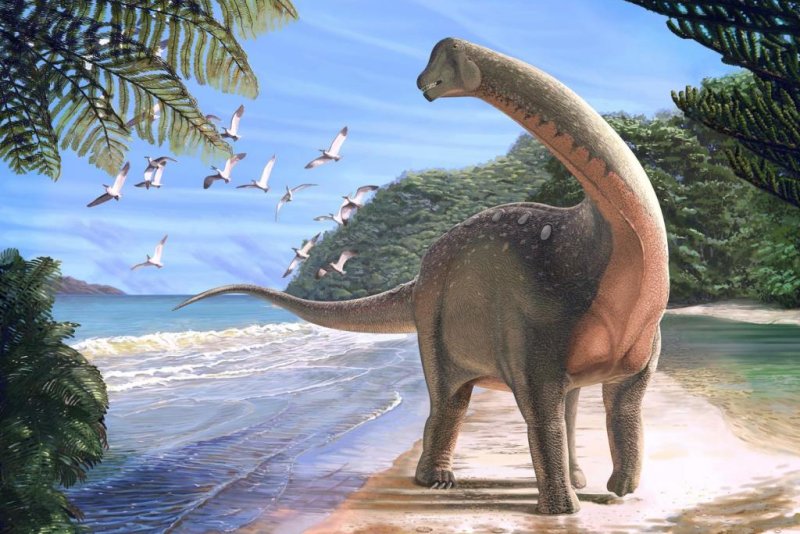An artistic rendering shows the titanosaurian dinosaur species Mansourasaurus shahinae on the coast of Egypt some 80 million years ago. Photo by Andrew McAfee/Carnegie Museum of Natural History
Jan. 29 (UPI) -- Scientists have found a new dinosaur species in Egypt, a discovery that promises new insights into Late Cretaceous dinosaur evolution in Africa.
The species, Mansourasaurus shahinae, was a titanosaurian, a group of sauropods. Like its relatives, the dinosaur featured a long neck and ate plants. The species was roughly the length of a school bus, and its skin was reinforced with hard, bony plates.
Mansourasaurus was discovered by a team of researchers from Vertebrate Paleontology Center at Mansoura University in Egypt.
"The discovery and extraction of Mansourasaurus was such an amazing experience for the MUVP team," lead researcher Hesham Sallam said in a news release. "It was thrilling for my students to uncover bone after bone, as each new element we recovered helped to reveal who this giant dinosaur was."
African dinosaur fossils from the Late Cretaceous period, between 100 to 66 million years ago, are rare.
"Mansourasaurus shahinae is a key new dinosaur species, and a critical discovery for Egyptian and African paleontology," said Eric Gorscak, a postdoctoral research scientist at Chicago's Field Museum. "Africa remains a giant question mark in terms of land-dwelling animals at the end of the Age of Dinosaurs. Mansourasaurus helps us address longstanding questions about Africa's fossil record and paleobiology -- what animals were living there, and to what other species were these animals most closely related?"
Unlike regions in Europe and North America, where geologic forces have brought ancient, fossil-rich rocks to the surface, much of the Africa strata where dinosaurs would expect to be found remains buried beneath thick vegetation.
The Cretaceous period marks the time when the supercontinent of Pangaea was beginning to break apart and continents began drifting into the configuration they're in today. The separation of Africa and its relationship to Europe, Asia and South America during this period isn't well understood.
Fossils can offer insights into the timeline of Pangea's breakup, which is why the dearth of African dinosaurs fossils has frustrated scientists.
Because Mansourasaurus shahinae is more closely related to European dinosaurs than species from Southern Africa or Asia, scientists suggest the fossil proves the connection between Europe and Africa remained strong late in the Age of Dinosaurs.
"Africa's last dinosaurs weren't completely isolated, contrary to what some have proposed in the past," said Gorscak. "There were still connections to Europe."
Researchers hope their discovery -- detailed this week in the journal Nature Ecology and Evolution -- is only the beginning of a renaissance of African dinosaur fossil finds.
"What's exciting is that our team is just getting started. Now that we have a group of well-trained vertebrate paleontologists here in Egypt, with easy access to important fossil sites, we expect the pace of discovery to accelerate in the years to come," said Sallam.















